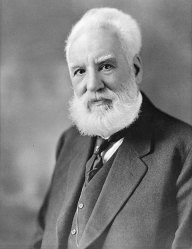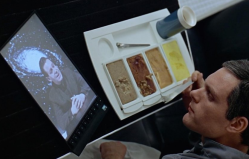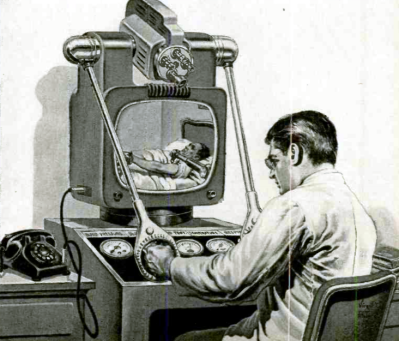Few occupations are more fraught with peril than predicting the future. If you are a science fiction author, it might not matter, but if you are trying to design the next game-changing piece of hardware, the stakes are higher.
It seems like, for the most part, even if you manage to get some of the ideas right, the form is often way off. Case in point: telemedicine. Today you can visit a doctor using video conferencing with your phone or a PC for many common maladies. A new idea? Not really. Hugo Gernsback wrote about it in Radio Electronics back in 1955.
Gernsback wrote:
The average medical doctor today is overworked and short-lived. There are never enough doctors anywhere for the world’s constantly multiplying population. Many patients die because the doctor cannot reach them in time, particularly at night and in remote regions.
…[H]e can only see a few [patients] during the day. With increasing traffic congestion, many doctors refuse to make personal calls — execept in emergencies. Even then they arrive often too late. Much of this dilemma will be archaic in the near future, thanks to the Teledoctor.
Gernsback envisioned a doctor using what we now call Waldos similar to what people use to manipulate radioactive material. These super mechanical hands (Gernsback’s words) would allow the doctor to write a prescription, pour liquids, or even diaper a baby thanks to a sense of touch built into them.
Oddly enough, Gernsback’s vision included renting a teledoctor from the drugstore for $3.50 a day. This way, the doctor could call on you and then follow up as well. The drug store would deliver the machine and it would — get this — connect to your phone:
A cord with the a telephone plug attached to the teledoctor instrument is now plugged into a special jack on your telephone. Future telephones will be provided with this facility. The TV signals and telehand electronic signals, etc., will all travel over the closed circuit telephone lines.
In a footnote, Gernsback notes that you can’t send a 525-line TV signal on current phone lines, but a 250-350 line picture was possible and that would be sufficient.
Visionary? In some ways, maybe. The basic idea is coming true today, although it isn’t likely doctors will do surgery or inject you remotely in your home anytime soon. The special telephone plug sort of came true and is already obsolete. The images, by the way, are the ones that accompanied the original article in Radio Electronics.
Other Predictions
 It seems like many new things are written off as fads by the establishment: cars, electricity, TV, smartphones, and telephones were all considered untenable by someone famous enough to matter. For example, apparently, Alexander Grahm Bell offered Western Union’s president the phone patent for $100,000 (a lot of money in 1876). The president’s internal memo on the subject reportedly said, “The idea is idiotic on the face of it. [W]hy would any person want to use this ungainly and impractical device when he can send a messenger to the telegraph office and have a clear written message sent to any large city in the United States.” Why indeed.
It seems like many new things are written off as fads by the establishment: cars, electricity, TV, smartphones, and telephones were all considered untenable by someone famous enough to matter. For example, apparently, Alexander Grahm Bell offered Western Union’s president the phone patent for $100,000 (a lot of money in 1876). The president’s internal memo on the subject reportedly said, “The idea is idiotic on the face of it. [W]hy would any person want to use this ungainly and impractical device when he can send a messenger to the telegraph office and have a clear written message sent to any large city in the United States.” Why indeed.
 On the other hand, Edward Bellamy, a science fiction author, predicted the debit card (and universal income) in 1888. Robert Boyle (the chemist who understood how gasses worked) predicted organ transplantation in the late 1600s. If you look closely at 2001: A Space Odyssey, you’ll see them using what amounts to a tablet computer to read the news and letters from home. Watching it today, it seems completely unremarkable.
On the other hand, Edward Bellamy, a science fiction author, predicted the debit card (and universal income) in 1888. Robert Boyle (the chemist who understood how gasses worked) predicted organ transplantation in the late 1600s. If you look closely at 2001: A Space Odyssey, you’ll see them using what amounts to a tablet computer to read the news and letters from home. Watching it today, it seems completely unremarkable.
However, for the most part, predictions are hit and miss. Even 2001: A Space Odyssey predicted moonbases and shuttles by 2001, which didn’t happen. The video below focuses on fashion for the year 2000 — as it seemed in the year 1939. Most of the predictions are a miss, but we did enjoy the very unusual looking man at the end wearing a phone and a radio.
The Last Few Decades
If you look back over the last few years, what would have surprised you before you saw it? A 32-bit computer with built-in WiFi for a few dollars? Speech recognition that works well enough to be a consumer item? How many things were called big hits that were really fads (say, the Segway) and how many fads were really big hits (cameras on cell phones)? Now look forward to the next 20 years. It is hard to imagine.
We’ve looked at bad predictions in the movies. We’ve also pondered the fate of the smoking robot from the 1930s.

No comments:
Post a Comment